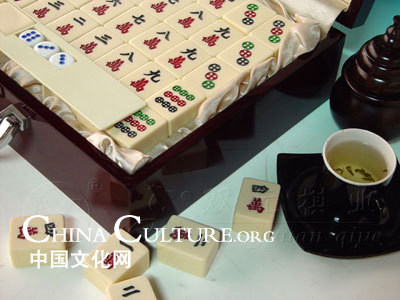Traditional Chinese culture in Mah-Jongg
Evolving from Liubo, an ancient Chinese game, Mah-Jongg is a traditional Chinese game with a history of thousands of years. With 144 Mah-Jongg tiles in a set, the game is designed for four players, each one with 13 tiles in a round. Each illustrated tile has its unique meaning, featuring distinctive characteristics and artistic conceptions of traditional Chinese culture.
 |
|
|
108 Mah-Jongg tiles Mirrors the ancient people’s cosmology
The illustrations on Mah-Jongg tiles originally derived from the 108 heroes of the traditional Chinese novel "Water Margin". It was said that there was a man named Wan Bingtiao in the late Yuan Dynasty (1271-1368) who respected the 108 heroes, so he designed Mah-Jongg with 108 cardinal tiles to symbolize them.
 |
|
|
The tiles consist of three suits numbering 1-9 (Dots, Numbers or Characters, and Bamboo, the "Ace" of which almost always looks like a bird), three different dragons (Red, Green, and White) and the four winds (east, south, west, and north).
 |
|
|
There are four copies of each tile. Special flower, season, and joker tiles may also be used.
In the bamboo suit, each stick is said to represent a string(条,Tiao); 9 is called “Jiu Tiao” (九条) because its Chinese pronunciation is similar to the hero Shi Jin’s nickname Jiu Tiao Long(literally means Nine Dragons in English), so Jiu Tiao symbolizes Shijin. And 2 is called “Er Tiao” (二条) in Chinese, which represents the hero Huyan Zhuo for his nickname is “Shuang Bian” (双鞭), which literally means double whips in English. In Chinese, the meaning of character “二” (Er) is equal to the character “双” (Shuang).
 |
|
|
The Wind tiles: East (东, dōng feng), South (南, nán feng), West (西, xī feng), and North (北, běi feng) represent the four directions.
 |
|
|
 |
|
|
The dragon tiles: red, green and white. Originally, these tiles are said to have something to do with the Chinese Imperial Examination. The red tile ("中"榜, zhōngbǎng) means passing the examination to clear the way to officialdom. The green tile ("发"财, fācái, literally "Get Rich") means wealth. The white tile (白版,báibǎn, literally "clean slate") means freedom from corruption. It usually has a blue border to distinguish from replacement tiles and prevent alteration. In the original Chinese Mahjong, the piece called "箭" (jiàn), represents archery, the red "中" represents a hit on the target. In ancient Chinese archery, one would put a red "中" to signify that the target was hit. White "白" represents failure, green "发" means that one will release the draw.
 |
|
|
 |
|
|
The ancient Chinese believed that the universe is composed of five elements of metal, wood, water, fire and earth. Each element matches a direction: wood matches east, metal matches west, fire matches south, water matches north and earth matches middle (red tile中). What’s more, dragon tiless are used to symbolize Heaven (天), Earth (地) and Human (人). The white tile represents earth; the green tile “发” not only means 发财(literally Get rich) but also means 头发(literally Hair), since hair is on the top of human body, which is used to represent the heaven; and the red tile “中” symbolizes both earth (地) and human(人).
















